This Special Release highlights the final results of the 2021 SICT for Core ICT Industries. The Core ICT Industries is comprised of the Information Economy (IE) and the ICT-Enabled Services. The IE is a term used to describe the economic and social value created through the ability to rapidly exchange information at anytime, anywhere to anyone. Meanwhile, the ICT-Enabled Services are those services that are delivered remotely over ICT networks (i.e. over voice or data networks, including the Internet).
1. ICT-Enabled Services had higher proportion of establishments that owned and used computers and communication equipment
A total of 3,678 establishments under the IE was estimated in 2021. Of this total, 3,667 establishments or 99.7 percent owned and used computers and communication equipment in their business operations. Meanwhile, ICT-Enabled Services had 1,299 establishments, of which 1,298 establishments or 99.9 percent owned and used computers and communication equipment in 2021. (Figure 1, and Tables A and 1)
There are two sectors under IE, namely, ICT sector and the Content and Media sector.
The ICT sector consists of the following:
a) ICT manufacturing industries;
b) ICT trade industries; and
c) ICT service industries.
The Content and Media sector, meanwhile, consists of the following:
a) Publishing activities;
b) Motion picture, video and television programme production, sound recording and music publishing activities; and
c) Programming and broadcasting activities.
All or 100.0 percent of the establishments under the Content and Media sector owned and used computers and communication equipment in 2021. Under the ICT sector, only establishments in the ICT manufacturing industries registered 100.0 percent ownership and usage of computers and communication equipment. (Figure 2 and Table 1)
2. ICT-Enabled Services had higher proportion of establishments with internet connection or access
Of the total number of IE establishments, 3,630 establishments or 98.7 percent had internet access in 2021. Meanwhile, 1,297 establishments or 99.8 percent of the total for the ICT-Enabled Services had internet connection or access in 2021. (Figure 3, and Tables A and 1)
Under the ICT sector, all or 100.0 percent of the establishments engaged in ICT manufacturing industries had internet access in 2021. The ICT service industries had 98.3 percent of establishments with internet access, while the ICT trade industries had 98.2 percent of establishments with internet access. Meanwhile, all or 100.0 percent of the establishments in the industries under the Content and Media sector had internet access. (Figure 4 and Table 1)
Among the types of transactions in the government offices availed by IE establishments, 2,594 establishments or 71.5 percent used the internet in downloading or requesting government forms. Meanwhile, 964 establishments or 74.3 percent in the ICT-Enabled Services used the internet for completing forms on-line or sending completed forms. (Figure 5 and Table 6)
The internet was also used by IE establishments for the following activities:
a. Obtaining information from other organizations, 2,338 establishments or 64.4 percent of the total number of IE establishments with internet;
b. Sharing or distribution of information within the establishment,1,833 establishments or 50.5 percent;
c. Sharing or distribution of information with other organizations,1,714 establishments or 47.2 percent;
d. Staff training, 1,656 establishments or 45.6 percent; and
e. Internal or external recruitment, 1,510 establishments or 41.6 percent. (Table 5)
Moreover, establishments under ICT-Enabled Services also used the internet for the following activities:
a. Internal or external recruitment and Staff training, both with 817 establishments or 63.0 percent of the total number of ICT-Enabled Services establishments with internet;
b. Sharing or distribution of information within the establishment,797 establishments or 61.4 percent;
c. Obtaining information from other organizations, 786 establishments or 60.6 percent; and
d. Sharing or distribution of information with other organizations,669 establishments or 51.6 percent. (Table 5)
3. ICT-Enabled Services had higher proportion of establishments with website
In 2021, the number of IE establishments with website reached 1,647 establishments or 44.8 percent of the total IE establishments. Meanwhile, the number of establishments with websites in the ICT-Enabled Services was recorded at 813 establishments or 62.6 percent. (Tables A and 2)
Among the industries under the ICT sector, ICT manufacturing industries had the highest proportion of establishments with website at 47.1 percent. Meanwhile, under Content and Media sector, the highest proportion of establishments with website was noted in the publishing activities at 66.5 percent. (Table 2)
4. ICT-Enabled Services had higher proportion of establishments with E-commerce transactions via the Internet
The number of IE establishments with e-commerce transactions via the internet in 2021 was recorded at 1,026 establishments or 27.9 percent of the total IE establishments. Meanwhile, establishments with e-commerce transactions via the internet in the ICT-Enabled Services was recorded at 712 establishments or 54.8 percent. (Figure 6, and Tables A and 3)
Under the ICT sector, ICT trade industries registered the highest proportion of establishments with e-commerce via the internet at 49.5 percent. This was followed by ICT manufacturing industries with 47.1 percent. Meanwhile, under the Content and Media sector, publishing activities recorded the highest proportion of establishments with e-commerce via the internet at 36.5 percent. (Figure 7 and Table 3)
5. IE had higher proportion of establishments that used cellular mobile phone/smartphone in business transactions
Cellular mobile phone/smartphone is another medium that can be used by establishments for doing business. Under the IE, 1,771 establishments or 48.2 percent used mobile phones in their business transactions in 2021. ICT-Enabled Services registered 452 establishments or 34.8 percent of the total ICT-Enabled Services establishments which used mobile phones for doing business transactions in 2021. (Tables A and 3)
ICT service industries surpassed other industries in the ICT sector in using mobile phones for their business transactions with 50.5 percent. Moreover, in the Content and Media sector, publishing activities had the highest proportion of establishments using mobile phones for their business transactions with 49.7 percent. (Table 3)
6. ICT-Enabled Services had higher proportion of establishments with social media account
In 2021, presence of social media account in the IE reached 2,234 establishments or 60.7 percent of the total IE. Meanwhile, ICT-Enabled Services reported 835 establishments or 64.3 percent of establishments with presence of social media account. (Tables A and 4)
Among the industries in the ICT sector, ICT service industries had the highest proportion of establishments with social media account at 59.0 percent. Meanwhile, in the Content and Media sector, motion picture, video and television programme production, sound recording and music publishing activities had the highest proportion of establishments with social media account at 78.5 percent, which was also the highest among the IE industries. (Table 4)
7. ICT-Enabled Services had higher proportion of employees routinely using computer at work
A total of 429,087 employees was recorded for IE, while 752,142 employees were reported under the ICT-Enabled Services in 2021. (Table 7)
The number of IE employees who routinely used computers at work was recorded at 248,441 employees or 57.9 percent of the total employees under IE in 2021. Meanwhile, the number of employees under the ICT-Enabled Services who routinely used computers at work was estimated at 627,823 employees or 83.5 percent. (Tables A and 7)
By industries in the ICT sector, ICT service industries had the highest proportion of employees who routinely used computer at work with 87.3 percent. Under the Content and Media sector, motion picture, video and television programme production, sound recording and music publishing activities had the highest proportion of employees who routinely used computer at work with 90.3 percent. (Table 7)
8. ICT-Enabled Services had the higher proportion of employees routinely using computer with internet connection/access at work
Under the IE, 228,632 employees or 53.3 percent routinely used computer with internet connection or access at work, while for ICT-Enabled Services 625,065 employees or 83.1 percent was recorded in 2021. (Tables A and 7)
Among industries in the ICT sector, ICT service industries had the highest proportion of employees routinely using computer with internet connection or access at work with 86.4 percent. Meanwhile, under the Content and Media sector, employees engaged in motion picture, video and television programme production, sound recording and music publishing activities had the highest proportion of employees routinely using computer with internet connection or access at work with 90.0 percent. (Table 7)
DIVINA GRACIA L. DEL PRADO, PhD
Assistant Secretary
Deputy National Statistician
Sectoral Statistics Office
_________________________
1 Source: United Nations Conference on Trade and Development (UNCTAD) Manual for the Production of Statistics on the Information Economy, 2009 Revised Edition
2 Source: United Nations Conference on Trade and Development (UNCTAD) Manual for the Production of Statistics on the Digital Economy, 2020 Revised Edition
TECHNICAL NOTES
2021 Survey on Information and Communications Technology
I. Introduction
I.1 Background of the survey
The 2021 Survey on Information and Communications Technology (SICT) is the ninth of the series undertaken by the Philippine Statistics Authority (PSA). It is a rider to the 2021 Annual Survey of Philippine Business and Industry (ASPBI) conducted in 2022. The 2021 SICT aims to collect and generate information on the availability, distribution, and access/utilization of Information and Communication Technology (ICT) among establishments in the country.
I.2 Objectives
The SICT aims to measure the following:
a. component of ICT resources and their utilization by establishments;
b. diffusion of ICT into establishments from various sources;
c. e-commerce transactions from data on e-commerce sales and purchases;
d. cellular mobile phone business transactions from data on sales and purchases;
e. estimate of the number of ICT workers in establishments;
f. methods of disposal of ICT equipment; and
g. presence of social media accounts.
I.3 Uses of data
The results of the survey will be used in the following:
a. assessing the use of ICT resources by establishments and the available infrastructure;
b. determining how establishments use the internet, including the activities for which it is used;
c. determining presence of Website among establishments;
d. determining the proportion of revenue generated through e-commerce transactions via internet, and through cellular mobile phones; and
e. determining the methods of disposal of ICT equipment.
I.4 Historical information on the survey
The first ever ICT survey was the 2002 SICT, with 2001 as the reference period. It was conducted in 2002 by the former National Statistics Office in collaboration with the Information Technology and E-Commerce Council of the Office of the President. It was followed by the surveys conducted in years 2009, 2010, 2011, 2014, 2016, and 2018 with reference years of 2008, 2009, 2010, 2013, 2015, 2017, and 2019, respectively. The 2013 SICT round and onwards were handled by the PSA after its creation in 2013 through Republic Act (RA) No. 10625 or the Philippine Statistical Act of 2013.
The data processing of accomplished questionnaires of the 2021 SICT is decentralized to the Provincial Statistical Offices (PSOs). Machine-data processing is implemented through the use of an online system called the Establishment Data Management System (EDMS).
I.5 Scope and coverage
Industries covered in the 2021 ASPBI were also covered in the 2021 SICT. These industries are classified as core ICT and non-core ICT industries. Core ICT industries are comprised of the Information Economy (IE) and the ICT-Enabled Services. IE refers to industries involved in producing and trading of ICT products, and those which primarily used ICT in providing products and services. Meanwhile, ICT-Enabled Services are services that are delivered remotely over ICT networks (i.e. over voice or data networks, including the Internet).
The IE is composed further of the ICT sector and the Content and Media sector. The industries under each sector are as follows:
a. ICT Sector
a.1 ICT Manufacturing Industries
a.2 ICT Trade Industries
a.3 ICT Service Industries
- Software publishing
- Telecommunications services
- Computer programming, consultancy and related services
- Data processing, hosting and related activities; web portals
- Repair of computers and communication equipment
b. Content and Media Sector
b.1 Publishing activities
b.2 Motion picture, video and television programme production, sound recording and music publishing activities
b.3 Programming and broadcasting activities
The industries which comprised the core ICT industries in the Philippines are listed in Table 1.
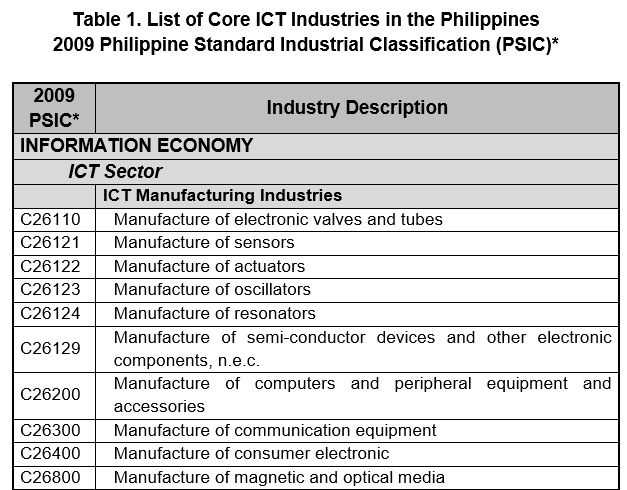
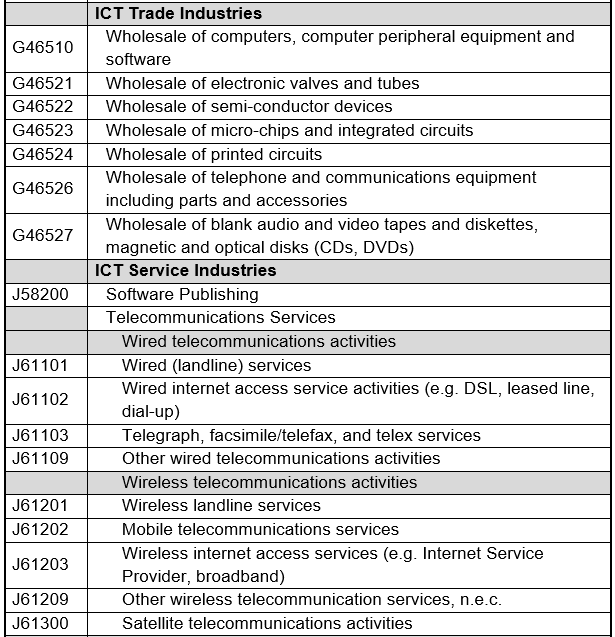
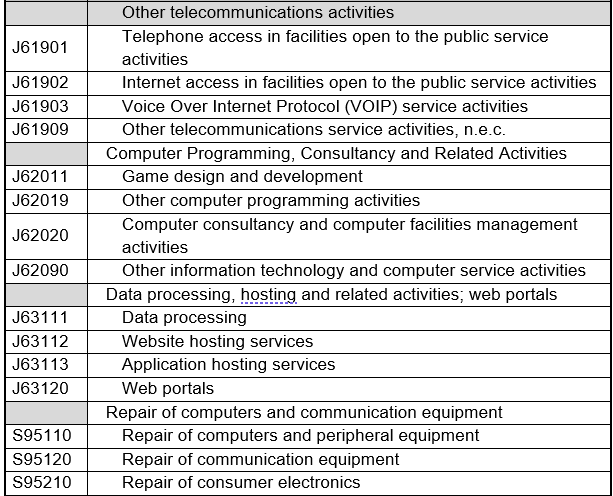



II. Data Collection
II.1 Data collection procedure
The survey was conducted nationwide in 2022 with 2021 as the reference period, except for employment where the reference period is as of 15 November 2021.
Distribution and collection of 2021 SICT questionnaires were done according to a timetable set. Distribution was conducted in April 2022 through personal visits by PSA field personnel to the sample establishments located in the provinces and cities nationwide. The collection of accomplished questionnaires started one week after distribution.
II.2 Instrument
Only one type of questionnaire for the 2021 SICT was utilized for all 18 sections of the economy as defined in the 2009 PSIC. The 2021 SICT Form 1 followed the 2019 SICT questionnaire design with minor revisions due to the addition of some data items and categories as recommended by the Department of Trade and Industry, and responses gathered from the 2019 SICT. The 2021 SICT questionnaire was reviewed and cleared under the Statistical Survey Review and Clearance System with clearance number PSA-2208 and expiry date of 28 February 2023.
II.2.1 Different Versions of the Questionnaire
a. Online Questionnaire – can be accessed by the sample establishments through the URL: https://sict.psa.gov.ph.
b. Electronic Questionnaire – this version can be accomplished in fillable PDF or in excel format. It can be requested by the sample establishment from the PSO personnel or Statistical Researchers (SRs) and will be emailed to them by the concerned PSO. The accomplished electronic questionnaire can be submitted through the email address of the concerned PSO.
c. Printed Questionnaire – This is the traditional and physical version of the questionnaire. The printed questionnaires were distributed to the sample establishments by the PSO personnel or SRs and collected one week after distribution.
II.3 Data items
Table 2 shows the main data items in the 2021 SICT questionnaire.
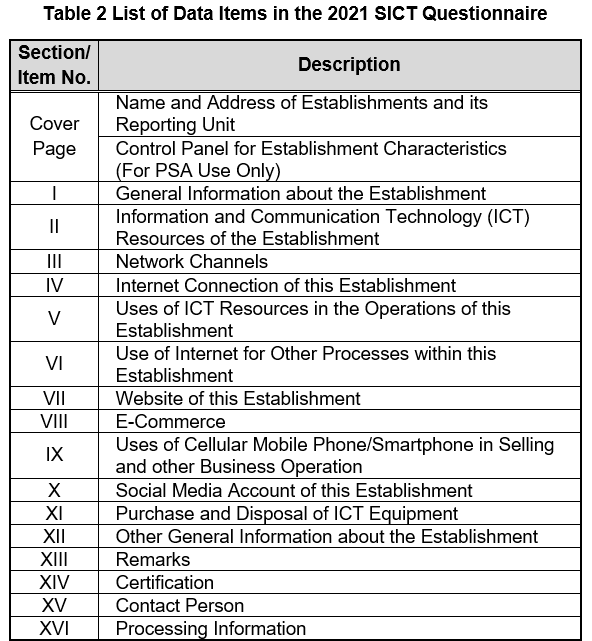
II.4 Data processing
To ensure quality of survey reports, several levels of validation following the guidelines set were done during the data processing phase of the survey operation.
Online systems were also developed and used to facilitate the smooth conduct and monitoring of the survey operation. These were the Monitoring and Tracking System (MTS) and the Establishment Data Management System (EDMS), both of which are online systems. The MTS was used to monitor the real-time progress of the survey operation, which included distribution, collection, transmittal, manual processing, and data processing of questionnaires, among others. Meanwhile, the EDMS was used in the processing of data and tabulation of survey results.
III. Methodology
III.1 Sampling frame
The frame for the 2021 SICT was extracted from the preliminary 2021 List of Establishments (LE) as of 24 January 2022. Samples were selected from the list of samples of the 2021 ASPBI, to ensure that the sample of SICT is a sample of ASPBI as well.
III.2 Sample selection procedure
III.2.1 Sampling design
The 2021 SICT utilized a stratified systematic sampling design with three-digit PSIC level serving as industry strata (industry domain) and employment size as the second stratification variable, except the Core ICT industries which was at the five-digit PSIC level.
Domain
The geographic domain of the core and non-core ICT industries is the region. The industry domain/stratum for the non-core ICT industries are the 3-digit PSIC industry groups, while for the core ICT industries are the 5-digit PSIC industry sub-classes. The employment domain/stratum is the Micro, Small, Medium, and Large classification.
Unit of Enumeration
The unit of enumeration of the survey is the establishment.
III.3 Estimation procedure
Core ICT Industries
1) Estimation of Survey Weights
Base Weight
The base weight is the inverse of the probability of selection. For the 2021 SICT, the base weight for each domain is given by:
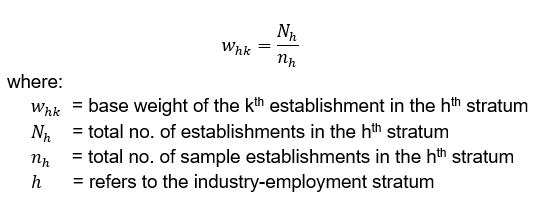
Adjusted Weight
Adjustment Factor Due to Non-Response
To take into account the non-responding sample establishments, the adjustment factor by region and industry domain is as follows:
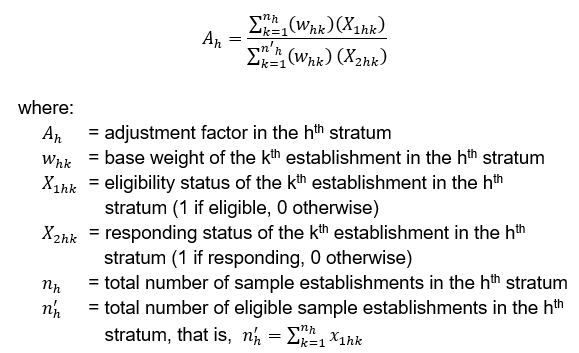
Adjusted Weight
The adjusted weight is the product of the base weight and adjustment factor due to non-response. That is,
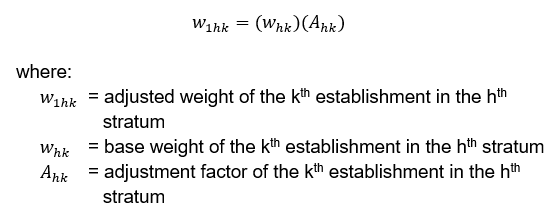
To consider the total industries covered in the ASPBI, additional adjustment factor is considered as follows:
Adjustment Factor for Conformity with ASPBI
In order to conform with the estimate of the total establishments in the ASPBI, final adjustment factor is computed as follows:

Final Weight
The final weight is the product of the adjusted weight and second adjustment factor. That is,
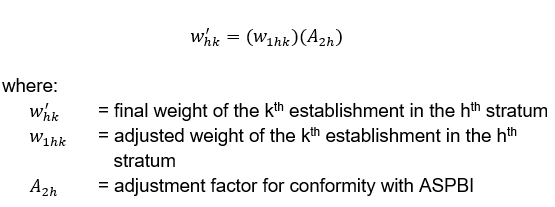
2) Estimation of Total
Total by Industry-Employment Stratum
The estimator for the total of a characteristic in each industry-employment stratum in a region (geographic domain) is given by:
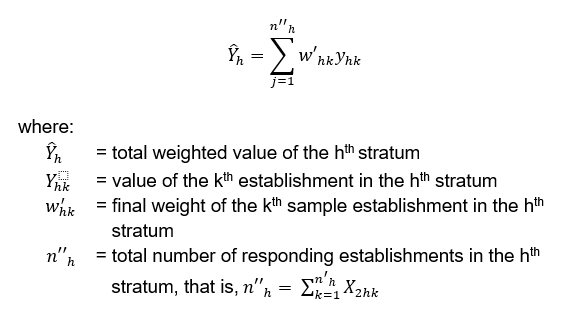
Total by Industry Stratum and Domain
The estimator for the total of a characteristic in each industry stratum in a domain is given by:
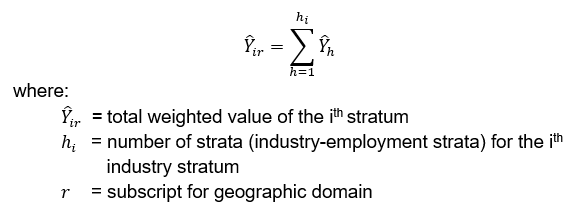
Total by Employment Stratum and Domain
The estimator for the total of a characteristic in each employment stratum in a domain is given by:
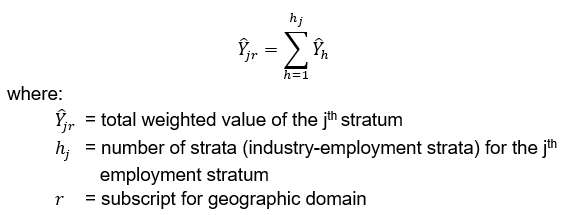
Total by Geographic Domain
The estimator for the total of a characteristic in each geographic domain is given by:
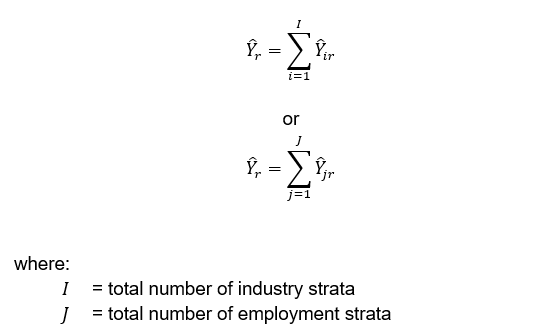
Total by Industry Stratum (National)
The estimator for the national total of a characteristic in each industry domain/stratum is given by:

Total by Employment Stratum (National)
The estimator for the national total of a characteristic in each employment domain/stratum is given by:

National Total
The estimator for the national total of a characteristic is given by:

III.4 Response Rate
The overall response rate for the 2021 SICT was 91.0 percent (16,377 of the 18,000 sample establishments). This included receipts of good questionnaires, partially accomplished questionnaires, and reports of closed, moved out, or out-of-scope establishments. Out of the total responding establishments, 881 establishments responded online. For Core ICT industries, the response is 89.8 percent (3,112 of the 3,467 sample establishments).
IV. Concepts and Definitions of Terms
Campus Area Network (CAN) is a computer network made up of an interconnection of local area networks (LANs) within a limited geographical area. It can be considered one form of a metropolitan area network, specific to an academic setting.
Commercial Off-the-Shelf (COTS) is a term for software or hardware, generally technology or computer products, that are ready-made and available for sale, lease, or license to the general public. They are often used as alternatives to in-house developments or one-off government funded developments.
Computer virus is a computer program that can copy itself and infect a computer without the permission or knowledge of the user. A true virus can only spread from one computer to another when its host (some form of executable code) is taken to the target computer, for instance, because a user sent it over a network or the Internet, or carried it on a removable medium such as a floppy disk, CD, or USB drive.
Custom software (also known as Bespoke software) is a type of software that is developed either for a specific organization or function that differs from or is opposite of other already available software (also called off-the-shelf or COTS software). It is generally not targeted to the mass market, but usually created for companies, business entities, and organizations. Custom software is also when companies or governments pay for customized software for budget or project managing.
Database is a structured collection of records or data that is stored in a computer system. The structure is achieved by organizing the data according to a database model. The model in most common use today is the relational model. Other models such as the hierarchical model and the network model use a more explicit representation of relationships.
Desktop computer is a personal computer (PC) in a form intended for regular use at a single location, as opposed to a mobile laptop or portable computer. Today the phrase usually indicates a particular style of computer case. Most modern desktop computers have separate screens and keyboards. A specialized form of desktop case is used for home theater PC systems, incorporating front-panel mounted controls for audio and video.
E-commerce or electronic commerce refers to the sale of goods and services, where an order is placed by the buyer, price and terms of sale are negotiated over the Internet Protocol-based networks, an extranet, Electronic Data Interchange (EDI) network, or other on-line system.
Extranet is a network or internetwork that is limited in scope to a single organization or entity but which also has limited connections to the networks of one or more other usually, but not necessarily, trusted organizations or entities (e.g. a company's customers may be given access to some part of its intranet creating in this way an extranet, while at the same time the customers may not be considered 'trusted' from a security standpoint).
Global Area Network (GAN) specifications are in development by several groups, and there is no common definition. In general, however, a GAN is a model for supporting mobile communications across an arbitrary number of wireless LANs, satellite coverage areas, etc. The key challenge in mobile communications is "handing off" the user communications from one local coverage area to the next.
ICT Resources are equipment, knowledge and human resources used to support electronic business/manufacturing processes and the conduct of electronic commerce transactions. It includes computer and peripheral equipment, systems and application software, network channels, telecommunication equipment, routers, satellite and other ICT hardware used in electronic business and commerce transactions, ICT support services and ICT workers.
Information and Communications Technology (ICT) as defined in RA No. 10844 of the Department of Information and Communications Technology Act is “the totality of electronic means to access, create, collect, store, process, receive, transmit, present and disseminate information”.
Information technology (IT), as defined by the Information Technology Association of America (ITAA), is "the study, design, development, implementation, support or management of computer-based information systems, particularly software applications and computer hardware". IT deals with the use of electronic computers and computer software to convert, store, protect, process, transmit, and securely retrieve information.
Internet is a global system of interconnected computer networks that interchange data by packet switching using the standardized Internet Protocol Suite (TCP/IP). It is a "network of networks" that consists of millions of private and public, academic, business, and government networks of local to global scope that are linked by copper wires, fiber-optic cables, wireless connections, and other technologies. The Internet carries various information resources and services, such as electronic mail, online chat, file transfer and file sharing, online gaming, and the inter-linked hypertext documents and other resources of the World Wide Web (WWW).
Intranet is a set of networks, using the Internet Protocol and IP-based tools such as web browsers and file transfer applications, that is, under the control of a single administrative entity. That administrative entity closes the intranet to all but specific, authorized users. Most commonly, an intranet is the internal network of an organization.
Landline, main line or fixed-line is a telephone line which travels through a solid medium, either metal wire or optical fibre. This is distinguished from mobile cellular line, where the medium used is the airwaves. Landlines usually cost less than cellular lines and provide better voice quality, and are used when there is no need for mobility or where cellular service is. A fixed phone line (i.e., one that is not a mobile phone line) can be hard-wired or wireless.
Laptop computer, also known as a notebook computer, is a small personal computer designed for mobile use. A laptop integrates all of the typical components of a desktop computer, including a display, a keyboard, a pointing device (a touchpad, also known as a trackpad, or a pointing stick) and a battery into a single portable unit.
Local Area Network (LAN) is a computer network covering a small physical area, like a home, office, or small group of buildings, such as a school, or an airport. Current LANs are most likely to be based on Ethernet technology. Each workgroup can get to its local printer. Note that the printers are not accessible from outside their workgroup.
Mainframes (often colloquially referred to as Big Iron) are computers used mainly by large organizations for critical applications, typically bulk data processing such as census, industry and consumer statistics, Enterprise Resource Planning, and financial transaction processing.
Metropolitan Area Network (MAN) is a network that connects two or more Local Area Networks or Campus Area Networks together but does not extend beyond the boundaries of the immediate town/city. Routers, switches and hubs are connected to create a Metropolitan Area Network.
Minicomputer (colloquially, mini) is a class of multi-user computers that lies in the middle range of the computing spectrum, in between the largest multi-user systems (mainframe computers) and the smallest single-user systems (microcomputers or personal computers).
Mobile phone (also known as a wireless phone, cell phone, or cellular telephone) is a long-range, electronic device used for mobile voice or data communication over a network of specialized base stations known as cell sites. In addition to the standard voice function of a mobile phone, telephone, current mobile phones may support many additional services, and accessories, such as Short Message Service for text messaging, email, packet switching for access to the Internet, gaming, Bluetooth, infrared, camera with video recorder and Multimedia Messaging Service for sending and receiving photos and video, MP3 player, radio, and Global Positioning System.
Network channel is a collection of computers connected to each other that allows them to communicate with each other, and share resources and information. All networks are made up of basic hardware building blocks to interconnect network nodes, such as Network Interface Cards (NICs), Bridges, Hubs, Switches, and Routers.
Office automation tool refers to all tools and methods that are applied to office activities, which make it possible to process written, visual, and sound data in a computer-aided manner. The term "office suite" refers to all software programs, which make it possible to meet office needs.
Open Source Software (OSS) began as a marketing campaign for free software. OSS can be defined as computer software for which the human readable source code is made available under a copyright license (or arrangement such as the public domain) that meets the Open Source Definition. This permits users to use, change, and improve the software, and to redistribute it in modified or unmodified form.
Operating System (commonly abbreviated OS and O/S) is the infrastructure software component of a computer system; it is responsible for the management and coordination of activities and the sharing of the limited resources of the computer. The operating system acts as a host for applications that are run on the machine. Common contemporary operating systems include Microsoft Windows, Mac OS, Linux, Berkeley Software Distribution, and Solaris.
Personal Area Network (PAN) is a computer network used for communication among computer devices close to one person. Some examples of devices that are used in a PAN are printers, fax machines, telephones, and Personal Digital Assistant barcode scanners. The reach of a PAN is typically about 20- 30 feet (approximately 6-9 meters), but this is expected to increase with technology improvements.
Personal Digital Assistant (PDA) is a handheld computer also known as palmtop computers. Newer PDAs also have both color screens and audio capabilities, enabling them to be used as mobile phones, (smartphones), web browsers, or portable media players.
Radio is the transmission of signals, by modulation of electromagnetic waves with frequencies below those of visible light. Information is carried by systematically changing (modulating) some property of the radiated waves, such as amplitude, frequency, or phase.
Satellite telephone, satellite phone, or satphone is a type of mobile phone that connects to orbiting satellites instead of terrestrial cell sites. Depending on the architecture of a particular system, coverage may include the entire Earth, or only specific regions.
Spam is the abuse of electronic messaging systems to indiscriminately send unsolicited bulk messages. While the most widely recognized form of spam is e-mail spam, the term is applied to similar abuses in other media: instant messaging spam, Usenet newsgroup spam, Web search engine spam, spam in blogs, wiki spam, Online classified ads spam, mobile phone messaging spam, Internet forum spam, junk fax transmissions, and file sharing network spam.
Spyware is computer software that is installed surreptitiously on a personal computer to intercept or take partial control over the user's interaction with the computer, without the user's informed consent. Spyware programs can collect various types of personal information, such as Internet surfing habits, sites that have been visited, but can also interfere with user control of the computer in other ways, such as installing additional software, and redirecting Web browser activity.
Virtual Private Network (VPN) is a computer network in which some of the links between nodes are carried by open connections or virtual circuits in some larger network (e.g., the Internet) instead of by physical wires.
Web site is a collection of Web pages, images, videos or other digital assets that is hosted on one or more web servers, usually accessible via the Internet. All publicly accessible websites are seen collectively as constituting the "World Wide Web". The pages of a website can usually be accessed from a common root Uniform Resource Locator called the homepage, and usually reside on the same physical server.
Wide Area Network (WAN) is a computer network that covers a broad area (i.e., any network whose communications links cross metropolitan, regional, or national boundaries. Less formally, a WAN is a network that uses routers and public communications links. The largest and most well-known example of a WAN is the Internet. A WAN is a data communications network that covers a relatively broad geographic area (i.e. one city to another and one country to another country) and that often uses transmission facilities provided by common carriers, such as telephone companies.
Worm can spread itself to other computers without needing to be transferred as part of a host, and a Trojan horse is a program that appears harmless but has a hidden agenda. Worms and Trojans, like viruses, may cause harm to a computer system's hosted data, functional performance, or networking throughput, when they are executed.
V. Dissemination of Results and Revision
Survey results were disseminated in the form of Special Releases and Infographics posted at the PSA website and electronic copy of publication reports.
VI. Citation
Philippine Statistics Authority. (January 2024). Technical Notes on the 2021 Survey on Information and Communications Technology (SICT).
VII. Contact Information
Soraya C. De Guzman
Chief Statistical Specialist
Services Statistics Division
Telephone No. (02) 8376-2090
ssd.esss.staff@psa.gov.ph
For data request, you may contact the:
Knowledge Management and Communications Division
Telephone No. (02) 8462-6600 loc. 839
info@psa.gov.ph
____________________________
1 refers to questionnaires with complete entries in the required data items
